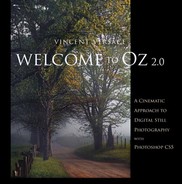Just Like the Movies: The Pre-Show Entertainment
If we have learned one thing from the history of invention and discovery, it is that, in the long run—and often in the short one—the most daring prophecies seem laughably conservative.
The only way to discover the limits of the possible is to go beyond them into the impossible.
—Arthur C. Clarke
Look at the image to your left and turn the book upside down.
Frequently in photography, as is the case in life, things are not what they appear to be.
When I was asked to revise this book, I decided that, rather than just update the keyboard commands and add a few of the new bells and whistles from CS5 and call it at day, it would be better to practice what I preach, which is that practice does not make perfect. Perfect practice makes perfect. So this book is not a revision. It is a complete re-write. The approach that I took when re-writing was to tell you what I would do today, this moment, with these images, as if I were working on them for the first time. I also felt it important to use a new image, shot with the largest file that I can produce, and show you a large megapixel workflow.
This book is about understanding the middle, the process of producing an image; what you should consider at the point of capture to create the very best print. For me, this is what the technical aspect of photography is all about.
One of the first changes you might notice in this book, is that two complete chapters are absent: the black and white chapter, and the chapter on time. Also, the book is 100 pages longer.
This book is now the first book in what will be a three, possibly four, book series, the first being Welcome to Oz 2.0: A Cinematic Approach to Digital Still Photography with Photoshop; the second, From Oz to Kansas: Almost Every Black and White Conversion Technique Known to Man (an expansion of the original black and white chapter into its own book); the third, Return to Oz (which will contain the chapter on time and will explore the conceptual difference between photographing the movement of time versus the motion of time); and the last book (should I live this long), Every Picture Tells a Story: Cinematic Digital Still Photography and 21st Century Composition Theory.
This book is not about how you can make my pretty pictures, it is about learning techniques that I believe will help you make your pretty pictures a closer reflection of the voice inside you. I want you to be able to make your own images, not just make a Xerox of mine.
The conversation that I want to begin with you in this first book of the Oz series is one concerning being taken by a photograph; to be so compelled by the image that you see in the viewfinder, to be so completely committed to the moment, that you do not take the image, the image takes you. Those are images that took your breath from you. It was that moment that made you want to convey that feeling to others. This book is about starting that journey.
